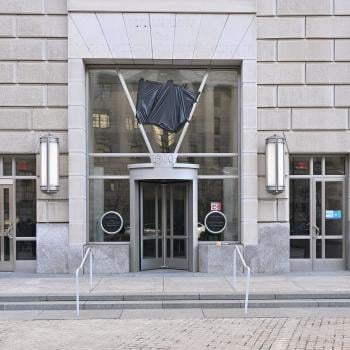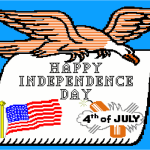How a Theologian’s Insight about Symbols Relates to the Present Kerfuffle about the Confederate Flag
For those of you not living in the United States I’ll briefly summarize a contemporary controversy stirring deep emotions especially in the Southern states.
A few weeks ago an emotionally disturbed young man with racist beliefs allegedly entered an African-American church in South Carolina and shot and killed a number of worshipers. Afterwards it was discovered that the accused young man used the main Confederate flag as a symbol on his Facebook page. African-Americans and some others have long associated the “Stars and Bars,” a battle flag usually thought of as “the Confederate flag,” with not only “Southern heritage” (as its users claim) but also as a symbol of racism. Since the massacre at the South Carolina church journalists, politicians and anti-racism activists have called for the retirement of that particular flag from public spaces and for its general recognition as a symbol of racism. Defenders of the flag, such as organizations composed of descendants of Confederate soldiers, have come to the flag’s defense saying it only represents Southern culture and heritage and not slavery. This has given rise to a new round of the old debate about the reasons for America’s Civil War or, as some in the South call it, the “War of Yankee Aggression.”
As I’ve watched and listened to this debate I have not been able to avoid thinking of Paul Tillich’s (d. 1965) famous and insightful distinction between “symbol” and “sign.” While the line between them can seem very thin and almost indistinct at times, and there are cases where it’s impossible to detect, Tillich’s distinction is important to keep in mind and use.
According to Tillich, who wasn’t wrong about everything and was very right about some things, a symbol participates in the reality to which it points whereas as sign does not. Practically speaking, that means a sign is replaceable without more than possible temporary confusion but a symbol creates a perception which has power to affect attitudes and actions. In other words, in the case of a symbol perception has reality beyond one person’s mind; in the case of a sign the perception is merely a signal that can just as well be made by something else. To boil it down, a true symbol has power; a sign does not. Put yet another way, nobody would die for a sign but many people will die for a symbol.
I’ll go out on a limb and risk being challenged by offering what to me seems like a good illustration most people can relate to. Imagine that a government entity decided, after due consideration and consultation with people who might be affected, that all “STOP” signs be replaced with “HALT” signs. They might, for example, decide that traditional stop signs are not working. (Right now many of them are being altered with tiny flashing red lights added to them to make them more noticeable, perhaps harder to ignore.) Some people might laugh; others might protest the expense of the replacement. But hardly anyone would chain themselves to a stop sign to keep it from being replaced or deface a halt sign out of outrage. Anyone who would do that would be considered by most people slightly “off balance” and hardly worth paying attention to. The traditional stop signs are only signs; not symbols. They don’t really stand for some “ultimate concern” or even penultimate concern. They don’t point to a reality beyond themselves, let alone participate in such a transcending reality.
But imagine a government entity deciding, even after due consideration and consultation with people who might be affected, that all American flags, the “Stars and Stripes,” be removed from public spaces. Of course, it’s unthinkable in reality; people would assume that somehow, without any other signal, the government had been infiltrated by and taken over by some foreign enemy. In other words, the United States flag, the “Stars and Stripes,” is much more than a sign; it is a symbol in Tillich’s term. Try burning an American flag in a public place; you’ll quickly find out (in most places) that it’s different than a stop sign.
Both sides in the current kerfuffle over the Confederate battle flag are demonstrating the truth of Tillich’s idea while at the same time ignoring it. It’s a paradox. On the one side are people who are loudly proclaiming that for them and their community, a large community that has suffered much oppression from the dominant culture, the “Stars and Bars” powerfully represents “white supremacy.” The other side vehemently denies it and claims it is just a sign of history and history should be remembered. Yet, many on this “other side” also claim it is a symbol of their ancestors’ heroism and of “Southern heritage.” Their vehement reaction to calls to take it down from all public spaces reveals that, for them, it is not merely a sign, to be kept in museums, for example, but a symbol in Tillich’s sense. For them it powerfully represents a transcending reality and participates in it.
Reflective, intelligent people on both sides of this debate realize that the Confederate battle flag, the “Stars and Bars,” is more than just a piece of cloth with some markings on it. I’m not sure its defenders really understand its power, however, or the manner in which it is being increasingly used by white supremacists. To them I would use this illustration. Suppose an immigrant community from Asia began using what most people call a “swastika” on their architecture in a largely Jewish community. To them, the Asians, it might genuinely be nothing more than a historical and cultural sign (using Tillich’s term). Or, it might be for them a powerful symbol of cultural history and heritage. Imagine their Jewish neighbors protesting the public display of that Asian figure in their midst or anywhere in the West—Europe or America. Their ears would be deaf to all claims that it is “only” an Asian religious symbol or sign. To them, the Jewish people, especially, it would be something else—inescapably. They could not be expected to overlook it or accept it as “just an Asian religious and cultural symbol.”
Am I comparing the “Stars and Bars” with the swastika? Well, yes and no. I’m comparing them in the sense that to some people they are both just harmless cultural symbols that should deeply offend no one. But I’m not comparing them in terms of atrocities—although I can understand why some African-Americans, especially descendants of slaves, might! But I am comparing them in terms of both being powerful symbols that have taken on lives of their own that represent something truly evil to many people.
Defenders of the Confederate flag claim that it does not represent slavery or white supremacy. Well, it might not to them. But what they are conveniently and ignorantly ignoring is that to many of their neighbors it does.
The solution is simple, really, even though it probably won’t satisfy most. The solution is to remove the “Stars and Bars” from public spaces and condemn its use by anyone suspected of white supremacy. By “condemn” I mean publically call them out and shame them. The solution also is to ignore its continued use by organizations dedicated to remembering the heroism and sacrifices of their ancestors—Confederate soldiers many of whom were against slavery. By “ignore” I mean not condemn or shame but respectfully recognize its meaning for them.
Both sides of the debate need to take more seriously consciously than many seem to the nature of the Confederate battle flag, the “Stars and Bars,” as a symbol in Tillich’s sense and that it represents and participates in different realities to different people. Because it so powerfully represents white supremacy to the majority of African Americans, especially in the South, and because it was a battle flag of a rebellion against the United States, it should be removed from all public spaces except museums, cemeteries (on specific graves of veterans of the Civil War) and gatherings of groups and sites dedicated to history (Civil War re-enactors, memorials, battlegrounds, etc.). People who wear or fly it apart from such specific places and events should expect to be identified by many others as white supremacists—whether they are in their own minds or not.












